50. In 1999, the 30th FAO Conference reaffirmed "the imperative of ensuring parity and balance in the use of all FAO languages and the need for supervision of the quality of translation and interpretation. In looking forward to further improvements in the future, the Conference agreed to the need for Members to monitor progress closely through periodic follow-up and evaluation"(C 99/REP, paragraph 94). This report on programme implementation now includes information on progress in the use of languages in meetings, publications, electronic material, terminology and on the human resource management implications of achieving language balance.
51. The policy governing the use of languages in FAO meetings that are convened by the Director-General under the FAO Constitution requires that the languages are decided by the body concerned, taking into account the geographical distribution of Members and their languages. The policy governing ad hoc and extrabudgetary meetings is more flexible, with language requirements being defined on a case-by-case basis. Adherence to the 1998 administrative guidelines for mandatory translation of FAO official documents for meetings and important publications is strictly monitored by the Office of the Director-General; the Corporate Communication Committee (CCC) oversees compliance with Director-General's Bulletin No. 99/3 of 4 March 1999 concerning the simultaneous production of publications in all five official languages. Operational procedures for multilingual publishing were issued in 2001 by the CCC and similar guidance provided for electronic material published by the World Agricultural Information Centre (WAICENT).
52. During the biennium, considerable improvements in the overall system of language management were effected to cope with increased work resulting from the implementation of the various operational procedures for simultaneous production of documents and publications in all five official languages. These combined efforts resulted in the Organization's positive performance on all indicators of language balance. Improvements in the system of language management included new technologies for terminology and translation outputs to facilitate the work of the translation teams; and new technologies to reduce the time taken to produce official meeting documents, both originals and in all language versions, and to enable more rapid simultaneous placement of documents in all languages on the FAO Web site. The Interdepartmental Working Group on Terminology was strengthened to enable timely updating and ensure accuracy of the terminology database. In mid-2001, a Special Allotment for Implementation of the Language Policy encouraged additional publications and contributed to improvements in language management systems.
53. The overall pattern of language use in meetings is determined by the body responsible for convening the meeting, the location of the meeting and the geographical distribution of the participants. Therefore, the pattern of language in meetings did not change significantly between 1998-99 and 2000-01. English is the predominant language used in meetings held at headquarters as well as in Asia and the Pacific and Europe. In Africa, French and English are nearly equally used. In Latin America and the Caribbean, the main languages are Spanish and English. In the Near East and North Africa, they are Arabic and English (Figure 2.6).
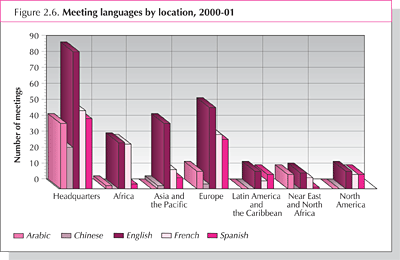
54. The main indicator of language balance for FAO meetings is the percentage of meetings held in all five official languages. There is a positive trend towards holding meetings in four or more languages. In 2000-01, the percentage of meetings held in all five languages increased to 12 percent from 9 percent in 1998-99. A small increase occurred in the percentage of meetings held in four languages, while there was a decline in the percentage of meetings held in three and two languages between 1998-99 and 2000-01 (Figures 2.7 and 2.8).
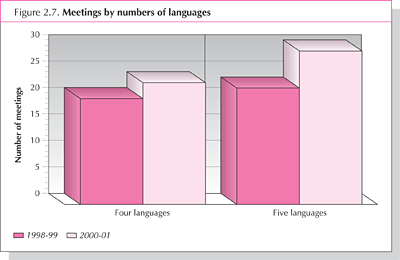
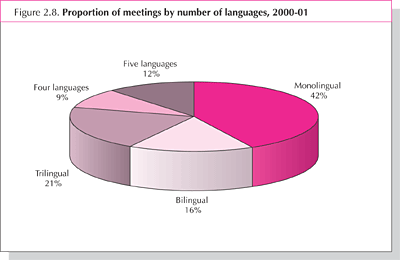
55. The trend towards holding meetings in more languages resulted in a significant increase in the number of interpretation days provided for FAO meetings during the biennium.4 The number of interpretation days recorded in this biennium was 8,655 days: an increase of 25 percent over 1998-99. As shown in Figure 2.9, the largest increase was in Chinese (+42 percent), followed by Arabic (+27 percent), French (+24 percent), English (+21 percent) and Spanish (+15 percent). The increase in interpretation days occurred both at headquarters and in the field, where a number of meetings were funded by extrabudgetary resources (Figure 2.10).
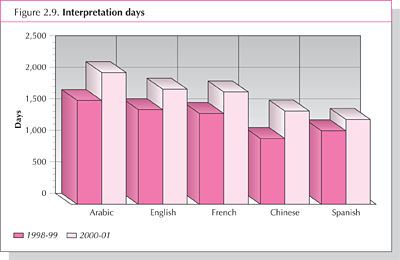

56. As a consequence of the increase in the language services provided by FAO, there has been significant growth in the workload, for which staff interpreters cover just 13 percent of the total. Staff interpreters are too few to provide even one full five-language interpretation team. Therefore, for most FAO meetings, interpretation services are mainly provided by external contractors engaged on the international circuit or available locally near conference sites. Although the arrangement provides flexibility, the very wide variety of contractors does not always assure consistent quality.
57. With regard to official meeting documentation, 2000-01 saw a marked increase in the volume of words translated in each language for all types of FAO outputs, with the overall total reaching 23.9 million words. This was 28 percent higher than the 18.6 million words translated in 1998-99. Increases in word volumes for Chinese, Arabic, Spanish and French were 71, 48, 15 and 11 percent, respectively (Figure 2.11).
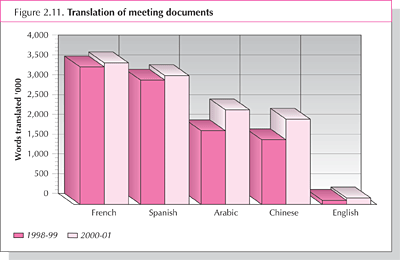
58. An intentional policy of outsourcing aimed at minimising translation costs has meant that there is significant reliance on external contractors to cover translation for meetings. For intergovernmental meeting documents, about 65 percent of the work in French and Spanish is contracted to freelance translators, compared with about 30 percent in previous years. Although qualified external translators are cost efficient and generally provide good linguistic quality, the consistency of technical terminology and correct use of FAO titles and expressions can best be assured by staff translators who are fully conversant with the Organization's complex texts and who are specialized in its field of work. With only 20 translator posts during 2000-01 to cover all FAO languages, the impact of the volume growth reduced the capacity of professional staff to revise external work to its lowest, raising concerns about the quality of language versions and their authoritative parity. While working methods have undergone radical changes and new technologies have been widely introduced since 1998, staffing levels may need new assessment to determine whether language services can be provided in accordance with the high professional standards expected of the Organization by its Members.
59. The Corporate Communication Committee determines policy concerning the language versions of FAO publications. All "flagship" publications, e.g. The State of Food and Agriculture, The State of the World's Fisheries and Acquaculture, State of the World's Forests, The State of Food Insecurity in the World and other major publications were published in all five languages during the biennium. Language versions of other publications are determined by the originator, based on an assessment of the target audience's needs.
60. During the biennium, there has been a significant improvement in the percentage of FAO publications in Arabic, Chinese and Spanish (Figure 2.12). In 1998-99, 54 percent of all priced publications and main documents were produced in English; this decreased to 41 percent in 2000-01. The percentage produced in French remained constant at 19 percent, Spanish increased from 16 to 19 percent, Arabic from 3 to 7 percent and the percentage of titles published in Chinese increased from 8 to 14 percent, largely as a result of the continuing arrangement with the Chinese Academy of Agricultural Sciences (CAAS). Achievement of the gains was facilitated by the special budgetary allotment made for this purpose in mid-2001.

61. Using funds provided under the special allocation to the Programme for the Improvement of Language Coverage, WAICENT introduced technical solutions to facilitate user access to FAO's electronic information in the five official languages during 2000-01. Further progress was achieved in facilitating navigation of the FAO Web site, and improving search and retrieval of information and information resources through the implementation of an improved WAICENT Information Finder, which features metadata databases that identify and classify FAO information in all official languages. The systems developed for this purpose were the Electronic Information Management System (EIMS) and the News and Events Management System (NEMS). Table 2.9 indicates the language coverage of news items of each system.
TABLE 2.9. NUMBER OF ITEMS BY LANGUAGE ON THE FAO WEB SITE AS REFLECTED IN THE CORPORATE SYSTEMS EIMS AND NEMS
English |
French |
Spanish |
Arabic |
Chinese | |
EIMS |
2,666 |
992 |
1,438 |
293 |
761 |
NEMS |
744 |
363 |
837 |
27 |
24 |
62. At the end of 2001, the FAOTERM terminology database consisted of 54,407 records in English, 51,168 in French, 46,261 in Spanish, 16,492 in Arabic and 11,878 in Chinese. The technical upgrade undertaken during 2000 enabled improvements to the Chinese and Arabic databases. Approximately 2,600 new terms were added during the biennium, bringing to 5,200 the number of new terms added to the database since the introduction of the multilingual terminology facility. The database allows direct interaction with computer-assisted translation tools, thus streamlining and harmonizing the language versions of FAO documentation. Care has been taken to monitor the quality of terminological records introduced into the database to guarantee its high quality as a reference tool. The five-language FAOTERM database was incorporated into the FAO Terminology Web site in January 2001 and resulted in increased use by FAO staff, other international organizations and the public in general. A new database for names of countries in five languages was also added to the FAO Terminology Web site .
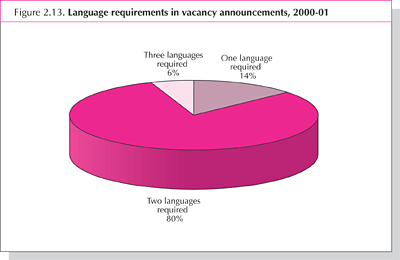
63. Language is related to the overall requirements of a post. For many posts above P2, a minimum of two languages is required. Figure 2.13 shows that 86 percent of vacant professional posts advertised in 2000-01 required two or three languages. Language proficiency is emphasized at the time of recruitment. Upon confirmation of appointment, newly recruited staff may be required to undergo a proficiency examination in the relevant official language(s) - English, French, Spanish, Arabic or Chinese. For many current staff, language proficiency has become an important criterion for promotion.
64. Approximately 25 percent of resources allocated to staff development are used to promote competence in a second or third language. Language training is organized by the Staff Development Group of the Human Resources Management Division (AFH). In 2000-01, some 460 staff participated in courses. Nine training levels were available and staff participating in the three hours per week training sessions could expect to move from zero ability up to working knowledge in three and a half years.
65. A new Programme Entity 222P5, Programme for the Improvement of Language Coverage, was included in the PWB 2000-01 to provide central support for:
66. Expenditures for these purposes totaled about US$1.2 million for the biennium. The specific use made of these funds was determined by the CCC and are described below. Resources within the programme entity also covered the continuing arrangement for translation of documents into Chinese undertaken in cooperation with CAAS and the unapportioned reserve.
67. Investments having an immediate impact included improved language coverage of FAO meetings, audio and video productions and important publications, as well as language training. Language coverage was expanded in the Regional Conferences in Latin America and the Caribbean and in Europe and in meetings of the Intergovernmental Groups on Commodities and Codex Alimentarius. However, the increased expenditure on translation and interpretation services far exceeded the US$350,000 allocation, thus indicating that departments improved language coverage of their meetings independently from the central facility. Additional audio and video materials were produced in Spanish, French and Arabic and were mainly focused on the SPFS, World Food Day and TeleFood activities and the WFS: five years later. Important publications for which language coverage was expanded included The State of Food and Agriculture, The State of Food Insecurity in the World and outreach publications such as Feeding Minds, Fighting Hunger, Working together and Food, Nutrition and Development. The resources for language training were concentrated on improving the language proficiency of professional officers and directors.
68. Investments in infrastructure included support for development of a language session management system to allow users to navigate across the FAO Web site in the five official languages and an integrated multilingual publishing environment. These have been discussed in the section above on Electronic material (WAICENT and the FAO Internet site). The Food Insecurity and Vulnerability Information and Mapping System (FIVIMS) was also assisted in extending its language coverage.
69. Investments to correct long-standing deficiencies mainly concentrated on the translation of additional titles into Chinese and Arabic. Resources were used to reduce the backlog of titles identified by CAAS and included technical publications related to soil management and conservation, food hygiene, meat inspection and fisheries management. Arabic publications included Feeding Minds, Fighting Hunger, documentation for the WFS: five years later and production of Arabic Web pages.
3 FAO meeting categories are Category 1: intergovernmental meetings; Category 2: technical sessions attended by experts designated by member governments; Category 3: committees and panels of experts composed of individuals selected in a personal capacity by FAO; Category 4: seminars, training courses and workshops. Under any of the categories, meetings can be convened either for statutory bodies, if they have been established, or on an ad hoc basis.
4 Interpreters are paid by the number of days the contractor is engaged for service in the booth; for non-local contractors, this includes travel days and weekend days between consecutive assignments.